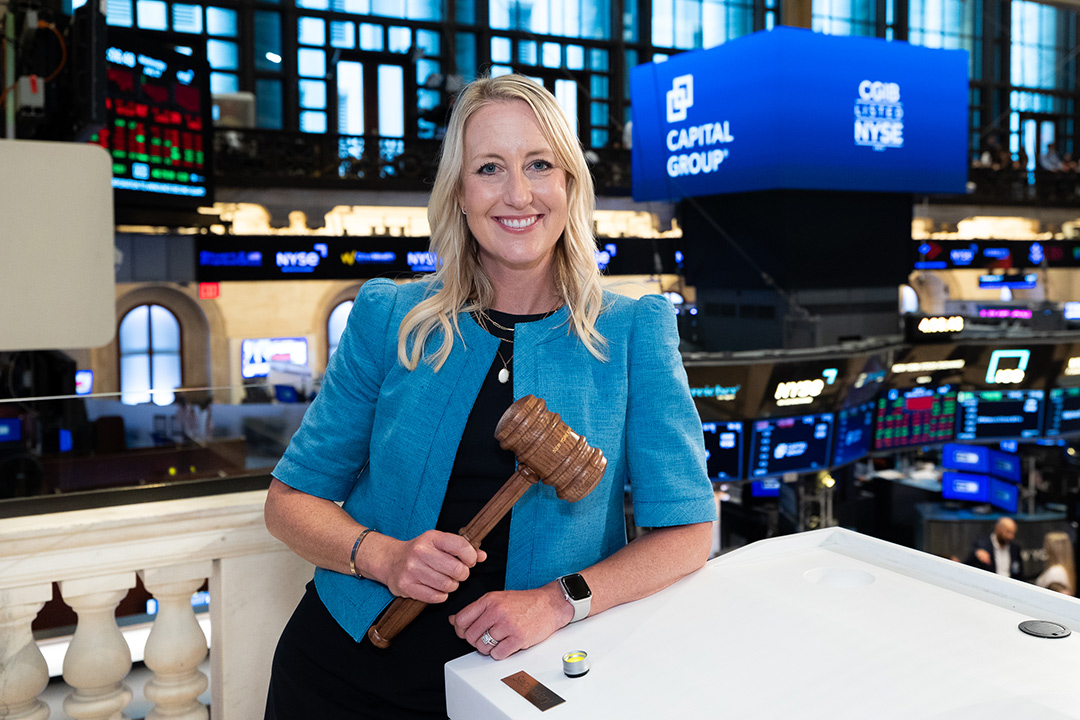PRODUCTS
Active ETFs designed to pursue superior outcomes
Our active ETFs are objective-oriented strategies that offer more choice for our investors along with the full support of Capital Group's extensive resources.

Capital Group named ETF Issuer of the Year!*
etf.com named Capital Group ETF Issuer of the Year on April 25, 2025, citing the rapid expansion of Capital Group’s active ETF suite in 2024. Capital Group debuted active ETFs in early 2022 and now offers 25 equity, fixed income and multi-asset ETFs plus eight active ETF model portfolios.
WHY CAPITAL GROUP?
Being truly active matters
Not all active management is created equal.
We’re truly active, which means we use proprietary fundamental research and investment insights gleaned from research trips, in-person meetings with management teams and cross-functional collaboration to build our portfolios. We’ve been active managers for 90+ years and bring this same approach to our ETFs.
(Pictured, Capital Group associate in Tokyo)


Truly active management feels different.
Partnering with us gives you highly experienced teams of portfolio managers, analysts and traders around the globe monitoring your investments and adjusting portfolios accordingly. Whether you’re building your own portfolios with our active ETFs or opting to use our active ETF model portfolios, confidence in your investments can free you up to spend more time supporting your clients and building your business.
(Pictured, Capital Group associates in London office)
Committed to leveraging the ETF vehicle.
ETFs provide transparency, intraday liquidity and tax efficiency and we’re committed to combining these benefits with Capital Group’s time-tested approach to active management. We publish our ETFs’ holdings daily, have a capital markets team supporting the liquidity of our funds and use the vehicle’s structure to actively manage the ETFs’ tax liabilities.
(Pictured, Capital Group associate at the New York Stock Exchange for a Capital Group ETF bell-ringing ceremony)

*Award Methodology: etf.com Award winners are selected in a three-part process designed to leverage the insights and opinions of leaders throughout the ETF industry.
Step 1
The awards process begins with open nominations, which will commence on December 2, 2024 and close on January 10, 2025. Interested parties are invited to submit nominations via the publicly available submission form. Self-nominations are accepted. A single fund/issuer can be nominated for multiple awards as long as it meets the criteria of the category. All entries related to funds are strictly for U.S.-listed ETFs.
Step 2
Following the open nominations process, the etf.com Awards Nominating Committee, made up of etf.com editorial staff, will review nominations. Nominations are screened for eligibility (appropriate timing and category). If more than five unique entries are received in the nomination process, the members of the Nominating Committee will force-rank their top five, resulting in a final slate for each category. Votes will be resolved on a majority basis, and ties broken where possible with head-to-head runoff votes. If ties cannot be broken, more than five finalists are allowed. The Nominating Committee will complete this process and short list of nominees will be published on etf.com on January 30, 2025.
Step 3
Winners among these finalists will be selected by a majority vote of the etf.com Award panel of judges, a group of independent ETF experts from the ETF industry. Judges will recuse themselves from voting in any category in which they or their firms appear as finalists. Ties will be decided where possible with head-to-head runoff votes. Voting will be complete by March 1, 2025. Results will be kept confidential until they are announced at the etf.com Awards ceremony on April 23, 2025 and published on etf.com following the live event.
©2025 Morningstar, Inc. All Rights Reserved. The information contained herein: (1) is proprietary to Morningstar and/or its content providers; (2) may not be copied or distributed; and (3) is not warranted to be accurate, complete or timely. Neither Morningstar, its content providers nor Capital Group are responsible for any damages or losses arising from any use of this information. Past performance is no guarantee of future results.
The Morningstar Medalist Rating™ is the summary expression of Morningstar’s forward-looking analysis of investment strategies as offered via specific vehicles using a rating scale of Gold, Silver, Bronze, Neutral, and Negative. The Medalist Ratings indicate which investments Morningstar believes are likely to outperform a relevant index or peer group average on a risk-adjusted basis over time. Investment products are evaluated on three key pillars (People, Parent, and Process) which, when coupled with a fee assessment, forms the basis for Morningstar’s conviction in those products’ investment merits and determines the Medalist Rating they’re assigned. Pillar ratings take the form of Low, Below Average, Average, Above Average, and High. Pillars may be evaluated via an analyst’s qualitative assessment (either directly to a vehicle the analyst covers or indirectly when the pillar ratings of a covered vehicle are mapped to a related uncovered vehicle) or using algorithmic techniques. Vehicles are sorted by their expected performance into rating groups defined by their Morningstar Category and their active or passive status. When analysts directly cover a vehicle, they assign the three pillar ratings based on their qualitative assessment, subject to the oversight of the Analyst Rating Committee, and monitor and reevaluate them at least every 14 months. When the vehicles are covered either indirectly by analysts or by algorithm, the ratings are assigned monthly. For more detailed information about these ratings, including their methodology, please go to global.morningstar.com/managerdisclosures/. The Morningstar Medalist Ratings are not statements of fact, nor are they credit or risk ratings. The Morningstar Medalist Rating (i) should not be used as the sole basis in evaluating an investment product, (ii) involves unknown risks and uncertainties which may cause expectations not to occur or to differ significantly from what was expected, (iii) are not guaranteed to be based on complete or accurate assumptions or models when determined algorithmically, (iv) involve the risk that the return target will not be met due to such things as unforeseen changes in management, technology, economic development, interest rate development, operating and/or material costs, competitive pressure, supervisory law, exchange rate, tax rates, exchange rate changes, and/or changes in political and social conditions, and (v) should not be considered an offer or solicitation to buy or sell the investment product. A change in the fundamental factors underlying the Morningstar Medalist Rating can mean that the rating is subsequently no longer accurate.

